
Hans von Aachen stands as a pivotal figure in the landscape of European art during the late 16th and early 17th centuries. Born in Cologne in 1552 and passing away in Prague in 1615, his life and career bridged the artistic traditions of Northern Europe with the innovations of the Italian Renaissance and Mannerism. As a highly versatile and sought-after painter, he excelled in portraiture, mythological scenes, religious subjects, and allegorical compositions, becoming a leading exponent of the international courtly style often associated with the reign of Holy Roman Emperor Rudolf II. His journey took him from the Rhine Valley to the heart of Italy and finally to the vibrant imperial capital of Prague, absorbing and synthesizing diverse influences to forge a distinctive and influential artistic identity.
Early Life and Artistic Formation in Cologne
Hans von Aachen entered the world in Cologne, a major cultural and economic hub on the Rhine River. While his surname suggests family origins in the nearby city of Aachen, he was firmly a product of Cologne's artistic environment. His initial training began in this setting, under the tutelage of a Flemish painter named Georg Jerrigh (also cited as E. Jerrigh), who had settled in Cologne. This early instruction would have grounded him in the Northern European artistic traditions, likely emphasizing detailed observation, craftsmanship, and perhaps the lingering influence of late Gothic aesthetics mixed with emerging Renaissance ideas filtering northwards.
Cologne in the mid-16th century was a city with a rich artistic heritage, but the most dynamic developments in painting were happening south of the Alps, in Italy. It was common for ambitious Northern artists to seek further education and inspiration there. Von Aachen was no exception. His foundational training with Jerrigh provided him with the necessary technical skills, but his artistic vision would be profoundly shaped by his subsequent experiences abroad. The precise duration of his apprenticeship is uncertain, but by his early twenties, he was ready to embark on the journey that would define his mature style.
The Transformative Italian Sojourn

Around 1574, Hans von Aachen traveled to Italy, the epicenter of artistic innovation during the Renaissance. This period, lasting approximately fourteen years, was crucial for his development. His first significant stop appears to have been Venice. The vibrant colours, dynamic compositions, and sensual textures of Venetian painting left an indelible mark on him. He is thought to have associated with the circle of Gaspar Rem, another Flemish painter active in Venice, possibly studying or working alongside his apprentice, Gherardo Stedum. More importantly, he absorbed the lessons of the great Venetian masters like Titian, Tintoretto, and Paolo Veronese, whose influence can be seen in his later handling of light, colour, and complex figural arrangements.
Following his time in Venice, von Aachen journeyed to Rome. Here, he encountered the monumental legacy of the High Renaissance, studying the works of Michelangelo and Raphael. Rome was also a crucible for the development of Mannerism, a style characterized by elegance, artifice, and sophisticated intellectual content. He would have seen works by leading Mannerists and perhaps encountered the burgeoning naturalism of early Baroque painters like Caravaggio, whose dramatic use of light and shadow (chiaroscuro) was beginning to cause a stir, although von Aachen's core style remained rooted in Mannerist elegance.
Florence, another key center of Mannerism, was also likely on his itinerary. The refined, courtly art of painters like Agnolo Bronzino and the theoretical underpinnings articulated by figures such as Giorgio Vasari would have further informed his understanding of contemporary artistic trends. Throughout his Italian stay, von Aachen not only studied Italian art but also interacted with the community of Northern European artists working there. He formed connections with influential figures like the Antwerp painter Bartholomeus Spranger and the Dutch master engraver and painter Hendrick Goltzius. These encounters were vital, fostering an exchange of ideas between Northern and Southern traditions and laying the groundwork for the international court style that would flourish in Prague.
Return to Germany and Ducal Patronage
Having spent over a decade honing his skills and absorbing the artistic currents of Italy, Hans von Aachen returned to Germany around 1588. He initially worked in his native Cologne before finding patronage in southern Germany, particularly in Munich and Augsburg. His sophisticated, Italianate style, combined with his Northern European grounding, made him highly sought after, especially as a portraitist. He gained commissions from prominent families, including the wealthy and influential Fugger banking dynasty in Augsburg.
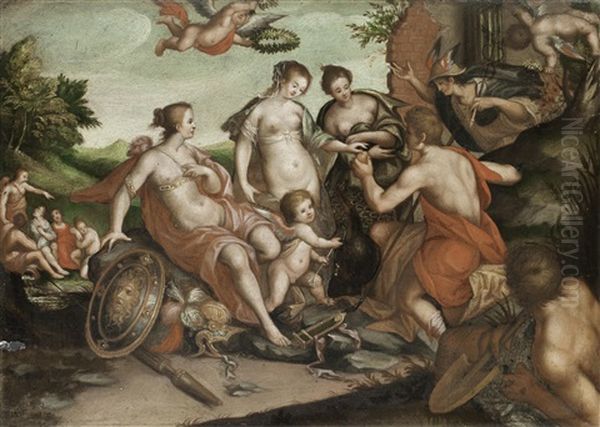
His reputation grew rapidly, leading to a significant appointment in Munich. He became a court painter to Duke Wilhelm V of Bavaria, a member of the powerful Wittelsbach dynasty. This position provided him with stability and prestige, allowing him to create portraits, religious works, and possibly allegorical paintings for the ducal court. His work during this period demonstrated his ability to blend flattering representation with psychological insight, a skill highly valued in courtly portraiture. His time in Munich also saw him marry Regina di Lasso, the daughter of the renowned Franco-Flemish composer Orlande de Lassus, who was the Kapellmeister at the Bavarian court, thus connecting von Aachen to the highest musical circles as well.
Imperial Service: The Court of Rudolf II in Prague
Hans von Aachen's success in Bavaria caught the attention of the highest patron in the Holy Roman Empire: Emperor Rudolf II. In 1592, Rudolf, an avid collector and patron of the arts and sciences residing in Prague Castle, appointed von Aachen as his imperial court painter (Kammermaler). Initially, von Aachen fulfilled his duties while remaining based primarily in Germany, likely traveling for specific commissions or consultations. However, the allure and opportunities of the imperial court eventually drew him eastward.
Around 1596 or 1597, Hans von Aachen relocated permanently to Prague, joining an extraordinary circle of artists, scientists, astronomers, alchemists, and intellectuals assembled by the emperor. Rudolf II's court was one of the most vibrant cultural centers in Europe, a hub for late Mannerism, often referred to as the Rudolfine style. Von Aachen quickly became a leading figure within this milieu, alongside artists he had previously encountered, such as Bartholomeus Spranger, and others like the sculptor Adriaen de Vries and the engraver Aegidius Sadeler. He also worked alongside the Swiss painter Joseph Heinz the Elder.
His role extended beyond simply painting. Von Aachen acted as an art advisor and agent for the emperor, undertaking diplomatic missions, particularly to Italy, to acquire artworks for Rudolf's burgeoning collections. His knowledge of the Italian art scene, his refined manners, and his artistic expertise made him invaluable to the emperor. In recognition of his services and artistic merit, Rudolf II ennobled him in 1605. He remained in imperial service even after Rudolf II was effectively deposed, continuing to work for Rudolf's brother and successor, Emperor Matthias.
Artistic Style: The Essence of Rudolfine Mannerism
Hans von Aachen's mature style is considered a prime example of Rudolfine Mannerism, an international court style characterized by sophistication, elegance, and intellectual depth. His art represents a masterful synthesis of the diverse influences he absorbed throughout his career. He combined the meticulous detail and observational realism associated with Northern European traditions, learned in Cologne, with the idealized beauty, graceful figures, and complex compositions he admired in Italian Renaissance and Mannerist art.
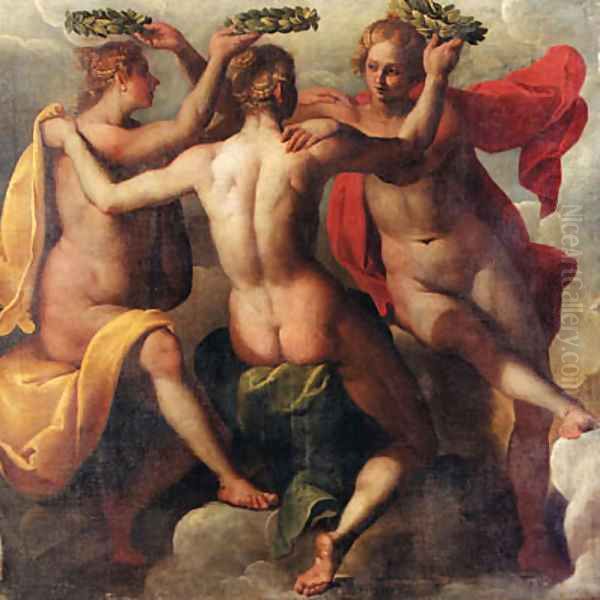
Key characteristics of his style include elongated human figures often depicted in elegant, twisting poses – the figura serpentinata favored by Mannerist artists. His compositions are frequently complex, featuring multiple figures interacting within allegorical or mythological narratives. There is often a refined sensuality, particularly in his depictions of the female nude, which he rendered with smooth, porcelain-like skin and graceful contours. His use of color is sophisticated, sometimes employing vibrant, almost artificial hues typical of Mannerism, while his handling of light and shadow (chiaroscuro) adds depth and drama, though generally less starkly than Caravaggio.
Von Aachen demonstrated remarkable versatility across genres. His portraits, such as those of Emperor Rudolf II or members of the Bavarian ducal family, combine accurate likeness with an air of aristocratic refinement and psychological nuance. His mythological and allegorical paintings, often laden with complex symbolism appealing to the erudite tastes of the imperial court, showcase his imaginative powers and compositional skills. He also produced religious works and even occasional genre scenes, like the early Two Drinkers, demonstrating a breadth of thematic interest. His work often possesses a subtle humor or wit, alongside its prevailing idealism.
Masterworks Under Scrutiny
Several key works exemplify Hans von Aachen's style and thematic concerns. His Bacchus, Ceres, and Cupid (c. 1600, Kunsthistorisches Museum, Vienna) is a classic example of his mythological paintings. It illustrates the Latin proverb "Sine Cerere et Baccho friget Venus" (Without Ceres [food] and Bacchus [wine], Venus [love] grows cold). The figures of the gods are depicted with characteristic Mannerist elegance and sensuality, arranged in a graceful, dynamic composition. The warm lighting and rich textures contribute to the painting's luxurious appeal.
The Judgment of Paris (various versions exist) was a popular theme, allowing artists to depict three idealized female nudes – Juno, Minerva, and Venus. Von Aachen's interpretations showcase his skill in rendering the human form, his sophisticated use of color, and his ability to create a complex narrative scene. An interesting anecdote, though perhaps apocryphal, suggests that the figure of Paris in some versions bears a resemblance to the artist himself, hinting at a personal connection to the subject.
The Three Graces (e.g., version in Detroit Institute of Arts) similarly explores themes of ideal beauty and classical mythology. The intertwined figures of Aglaia, Euphrosyne, and Thalia are rendered with graceful lines and delicate modeling, embodying the elegance and refinement prized at the Rudolfine court. Another significant allegorical work is The Triumph of Truth and Justice (Detroit Institute of Arts), a complex composition likely commissioned to convey political or philosophical ideals important to his patrons.
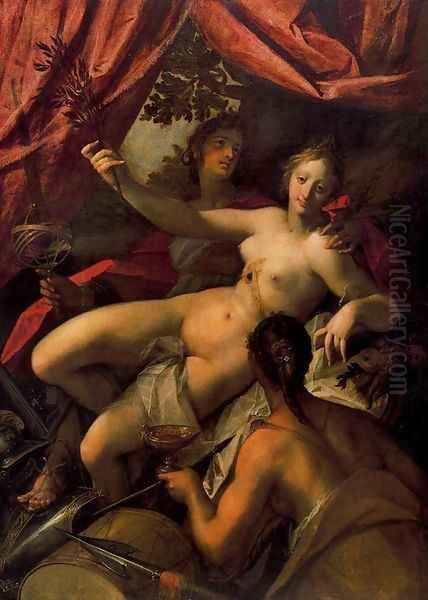
His portraiture remained a cornerstone of his output. His official portraits of Emperor Rudolf II project an image of imperial majesty combined with the emperor's known intellectual and introspective nature. Earlier portraits, like those for the Bavarian court or the Fugger family, demonstrate his consistent ability to capture both likeness and status. He also produced compelling self-portraits, offering glimpses into his own persona. Furthermore, von Aachen was known for creating small, highly finished paintings on copper, often featuring mythological or allegorical subjects. These intimate works were prized by collectors for their exquisite detail and jewel-like quality.
Circle of Influence: Contemporaries and Collaborators
Hans von Aachen did not work in isolation. His career was interwoven with interactions with numerous other artists, patrons, and intellectuals. His time in Italy brought him into contact with Spranger and Goltzius, relationships that likely continued or were renewed in Prague. At the imperial court, he was part of a vibrant artistic community. He worked alongside Spranger, Joseph Heinz the Elder, and Adriaen de Vries, contributing to the distinctive character of Rudolfine art. While each artist had his own style, there was a shared language of elegant Mannerism, sophisticated allegory, and often, a subtle eroticism.
The dissemination of his work was greatly aided by engravers who translated his paintings into prints. Chief among these was Aegidius Sadeler, a member of a renowned family of engravers who worked extensively at the Prague court. Other notable engravers who reproduced von Aachen's designs include Jan Muller and Dominicus Custos. These prints circulated widely across Europe, making von Aachen's compositions known far beyond the confines of the imperial court and influencing artists in the Netherlands, Germany, and even Italy.
His connections extended beyond the visual arts. His marriage to Regina di Lasso, daughter of the celebrated composer Orlande de Lassus, placed him within a prominent musical family during his time in Munich. In Prague, his role as court painter and art advisor involved constant interaction with court officials, diplomats, and the emperor himself, requiring not only artistic skill but also social adeptness.
Teaching and Lasting Legacy
As a leading master, Hans von Aachen also played a role in educating the next generation of artists. Among his notable pupils were Pieter Isaacsz., who later had a successful career as a painter and art dealer in Amsterdam and served the Danish court, and Joseph Heinz the Elder, who, although also a contemporary and collaborator at the Prague court, is sometimes considered to have been influenced by or even studied with von Aachen. Other potential students or followers mentioned include Johann von Strupp and Hans Christoph Schürer.
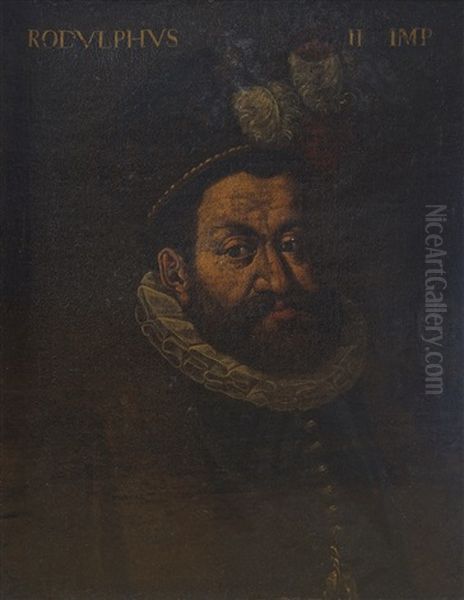
However, von Aachen's most significant influence was arguably exerted through the widespread circulation of prints after his designs. These engravings and etchings ensured that his elegant figural style, complex compositions, and popular mythological and allegorical themes reached a broad audience of artists and collectors. His synthesis of Northern and Italian elements provided a model for artists seeking to create sophisticated, internationally appealing work. While the Mannerist style would eventually be superseded by the Baroque, von Aachen's art, particularly its elegance and refinement, left a mark. Some art historians suggest echoes of his approach can be found in the early work of Baroque masters like Peter Paul Rubens, who similarly forged a powerful synthesis of Northern and Southern European traditions.
Today, Hans von Aachen's works are held in major museums around the world, including the Kunsthistorisches Museum in Vienna, the Alte Pinakothek in Munich (Bavarian State Painting Collections), the National Gallery in Prague, the State Hermitage Museum in St. Petersburg, the Metropolitan Museum of Art in New York, the Getty Museum in Los Angeles, and the Detroit Institute of Arts. His paintings and drawings continue to be studied for their technical brilliance, their embodiment of Rudolfine court culture, and their crucial role in the transmission and transformation of artistic ideas across Europe at the turn of the 17th century.
Final Years and Enduring Reputation
Hans von Aachen remained active in Prague during the turbulent final years of Rudolf II's reign and continued his service under Emperor Matthias after Rudolf's death in 1612. Despite the political uncertainties and the eventual decline of Prague as the primary imperial residence after Matthias moved the court back to Vienna, von Aachen stayed in the Bohemian capital where he had established his life and career.
He continued to paint, likely fulfilling commissions for the new emperor and other patrons, although perhaps the unique creative atmosphere fostered by Rudolf II had somewhat diminished. Hans von Aachen died in Prague on March 4, 1615, at the age of 63. At the time of his death, he was one of the most respected and internationally recognized German artists of his generation, a testament to his talent, his adaptability, and his successful navigation of the complex world of court patronage.
Conclusion: A Bridge Across Cultures
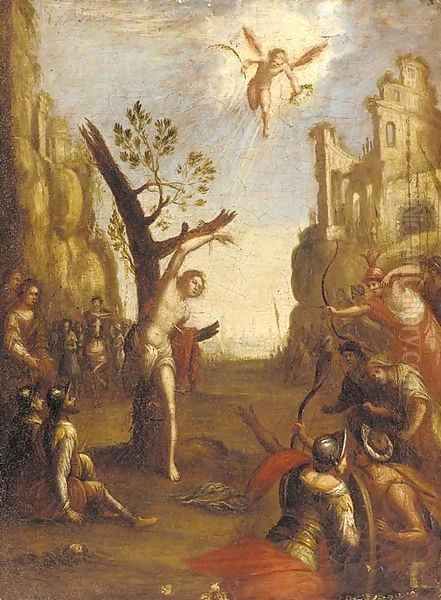
Hans von Aachen's career exemplifies the rich cultural exchange that characterized European art in the late Renaissance and Mannerist periods. From his early training in Cologne to his transformative years in Italy and his culminating success at the imperial court in Prague, he consistently absorbed, synthesized, and refined diverse artistic influences. He mastered multiple genres, creating psychologically astute portraits, elegant mythological and allegorical scenes, and compelling religious works. As a key figure in the Rudolfine circle, he helped shape a sophisticated international court style that blended Northern detail with Italian grace. Through his own paintings and the numerous prints made after his designs, his influence extended across Europe, contributing to the complex artistic landscape at the dawn of the Baroque era. Hans von Aachen remains a significant figure, recognized for his technical mastery, his stylistic synthesis, and his role as an artistic bridge between North and South during a fascinating period of European art history.